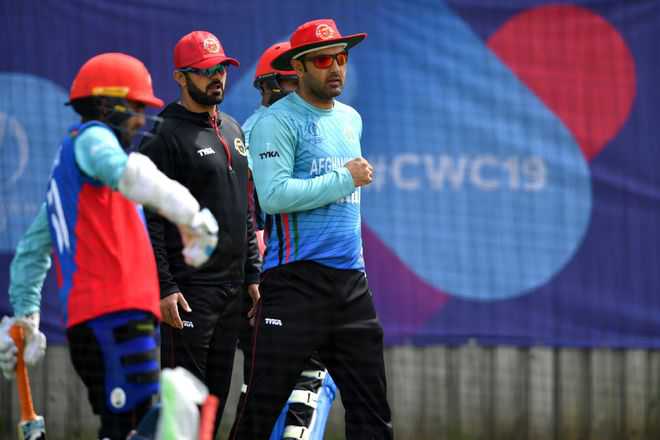Rohit Mahajan
Tribune News Service
Southampton, June 21
Amateur daredevilry even while playing against hardened pros; big fast bowlers with dangerous eyes and flying manes, such as Shapoor Zadran; a comically rotund opening batsman who can whack the leather off the ball, such as Mohammad Shahzad. Men who bristle when asked if they are afraid of bouncers by fast bowlers — imagine, an Afghan man being scared of the cricket ball! ‘No’, they answer indignantly, eyes blazing, ‘we’re not afraid, Afghan people are not afraid’.
This primeval masculinity might put off some people, but there’s much to like about Afghanistan. Above all else is their astonishing emergence as a force in world cricket out of nowhere, over the last 18 years. Take their record against West Indies over the last two years, for instance: Afghanistan have a 3-1 win-loss record against an old and established team such as West Indies.
Neo-colonial plant
Some excellent cricketers have emerged from the war-torn nation; cricket was planted in various countries across the world through the vehicle of colonialism; Afghanistan is the only nation in which cricket was planted through the neo-colonialism, of the US and USSR. You’d think that the Afghanistan story would be loved and encouraged. But no. They’re not heartily welcomed by the big boys of world cricket. India, for instance, are yet to play Afghanistan in an ODI match in India, though India did host their inaugural Test last year.
Before this World Cup, Afghanistan had never played an ODI in England and Wales. Before the 2015 World Cup in Australia and New Zealand, they’d never played an ODI in those two countries. How, then, can anyone expect Afghanistan to be top-notch at the World Cup?
Losing run
Afghanistan have lost all five matches in this World Cup, the smallest margin being 34 runs, against Sri Lanka. At the 2015 World Cup, they had played six games and lost five, the one win coming against Scotland.
This time around, there’s no Scotland — the World Cup was reduced from 14 teams in 2015 to 10 teams this time around. All other teams are ranked higher than Afghanistan — them scoring a win this time around is a lesser possibility, then.
What Afghanistan need is more cricket against the best teams, in different conditions. They’re not getting it. They won’t get it, too.
The captain, Gulbadin Naib, says the team needs to play against stronger teams. “Yeah, sure, we want also (to play),” he said. “If you look for we’re not playing against the other teams, but we do very well. We want to improve our experience, so we should play against good teams like India, Australia, South Africa, Pakistan.”
“If you’re targeting like the top five or top six teams, we should play a lot with them,” he added. “If we play with them, maybe Afghanistan will be… Yeah, we will be losing the matches, or we will be struggling. But one day Afghanistan will be different.”
Unequal fight
To fight against the big boys, to equal them, to beat them one day — that’s how a team grows in strength and confidence. That’s how India grew, that’s how teams such as Sri Lanka and Bangladesh grew. Afghanistan need the opportunity — but big teams have no time for them.
“It’s not only me, but a lot of people believe that the ICC prefers money, rather than expanding this beautiful game of cricket. They are not doing enough,” said BBC journalist Emal Pasarly, who has followed Afghan cricket right from the beginnings and recently published a history of the sport there. “The big teams are playing only among themselves. As long as ICC and the Asian Cricket Council (ACC) don’t support teams like Afghanistan and Nepal and Ireland and so on, I don’t think these teams will be good. I hope that by the next World Cup, the ICC and other cricket bodies will look into this so that the less powerful teams are able to compete.”
Money matters
Cricket — all sport, indeed — is driven by money. An England-Australia or an India-Pakistan series generates big money. The broadcasters want only big matches in events such as the World Cup — that’s the reason the World Cup has been reduced from 14 to 10 teams.
Afghanistan have entered the World Cup club, but there’s little effort by the other nations to shepherd them; India has done a bit by providing them training facilities and ‘home venues’ in India. But no one is keen to host a less financially money-spinning team such as Afghanistan.
“If you look at the schedule of the top eight teams, it’s very tight… They have not enough time (so) we play series against them,” Naib said. “But our board is trying to arrange the series, especially against like Pakistan, against India… But they didn’t have a lot of time.”
No time for the ‘minnows’ — only once in four years, they’re thrown before the big boys, to be mauled, and then it’s back to the hinterlands of cricket.
Unlock Exclusive Insights with The Tribune Premium
Take your experience further with Premium access.
Thought-provoking Opinions, Expert Analysis, In-depth Insights and other Member Only Benefits
Already a Member? Sign In Now










